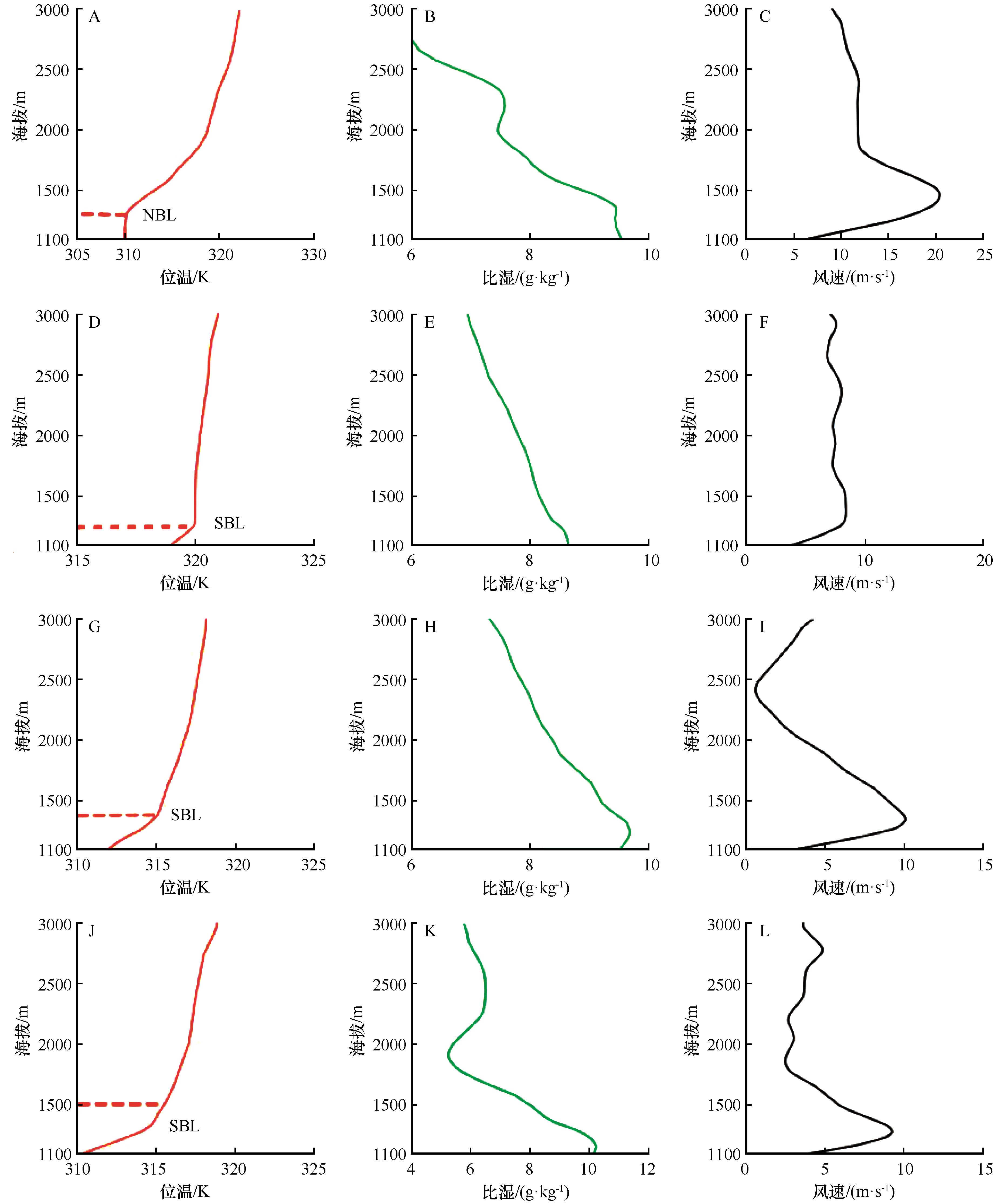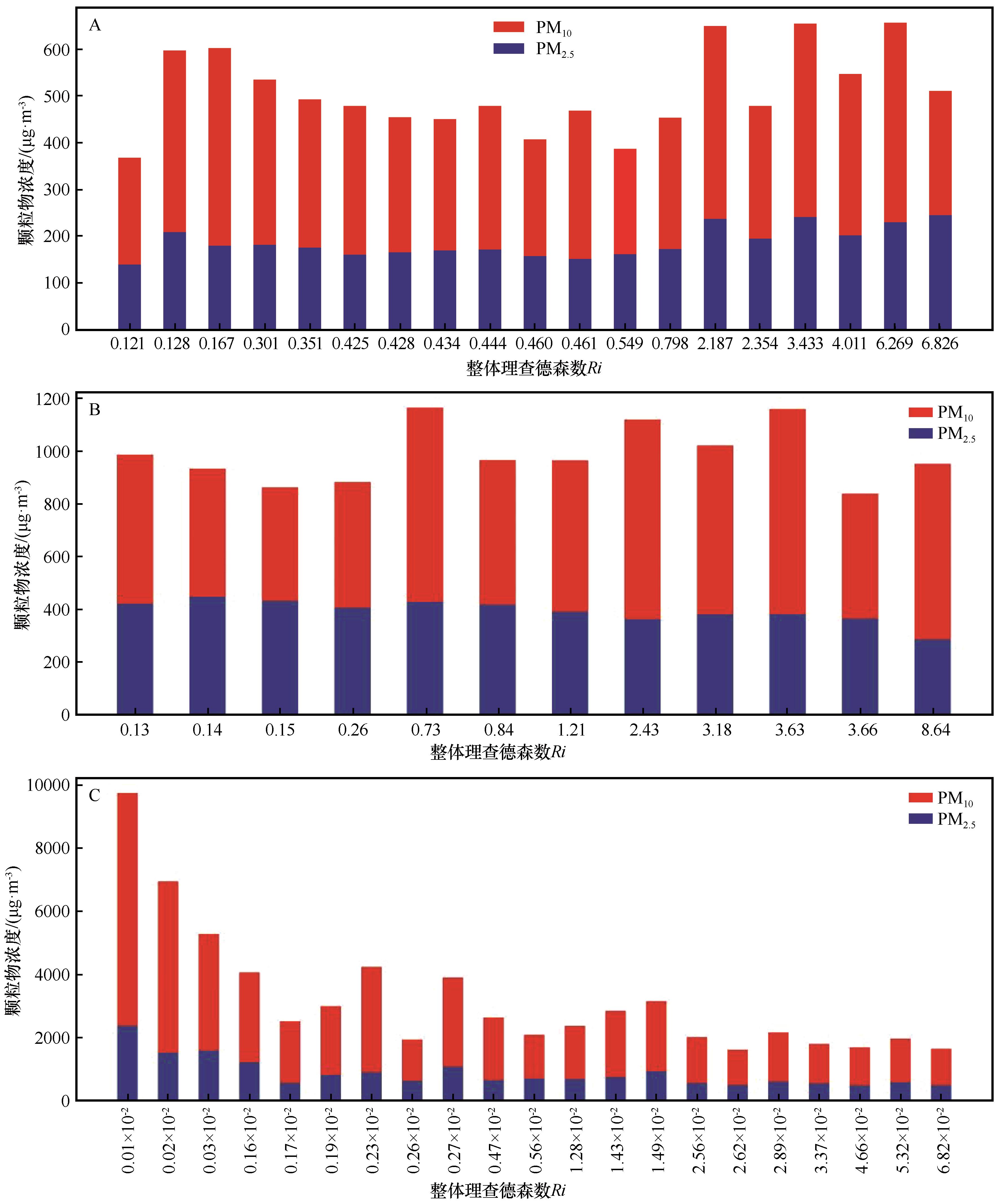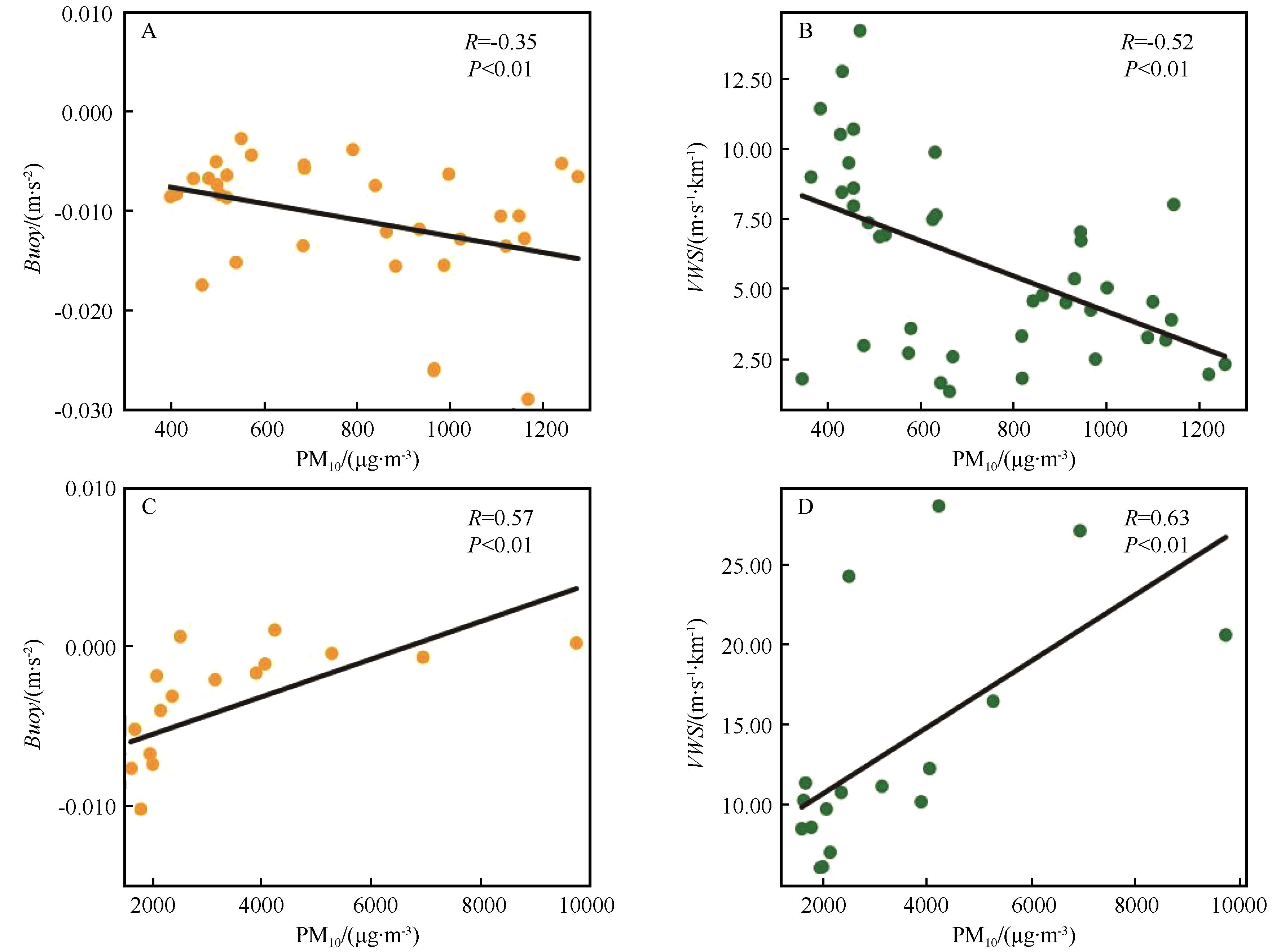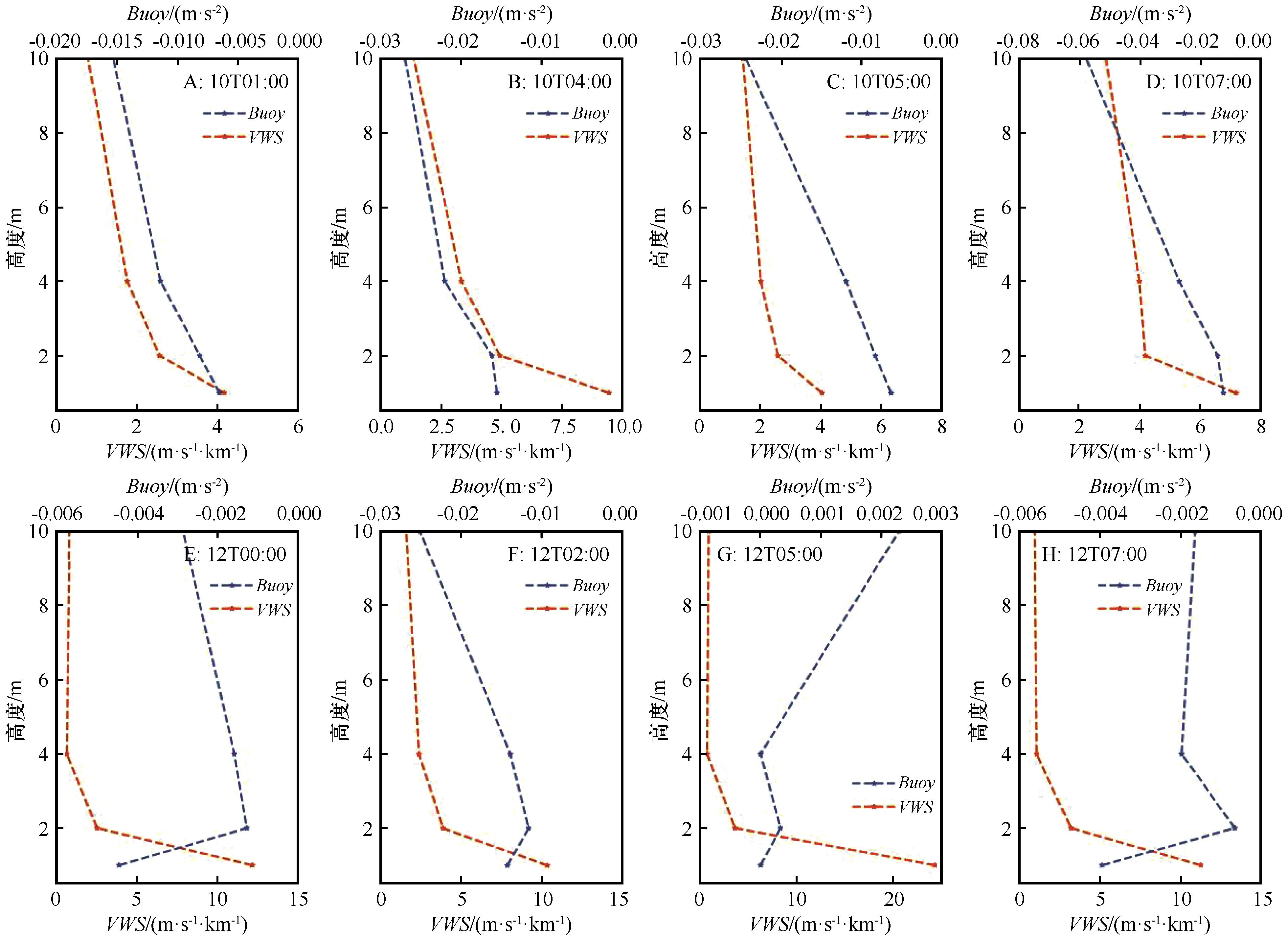
- CN 62-1070/P
- ISSN 1000-694X
- Bimonthly 1981

Journal of Desert Research ›› 2024, Vol. 44 ›› Issue (5): 1-12.DOI: 10.7522/j.issn.1000-694X.2024.00020
Previous Articles Next Articles
Congzhen Zhu1( ), Jicheng Luo2, Minzhong Wang1(
), Jicheng Luo2, Minzhong Wang1( ), Lu Meng1, Honglin Pan1, Jiantao Zhang1
), Lu Meng1, Honglin Pan1, Jiantao Zhang1
Received:2023-12-15
Revised:2024-01-31
Online:2024-09-20
Published:2024-10-15
Contact:
Minzhong Wang
CLC Number:
Congzhen Zhu, Jicheng Luo, Minzhong Wang, Lu Meng, Honglin Pan, Jiantao Zhang. Characteristics of the summer nighttime stable boundary layer in the hinterland of the Taklamakan Desert and its effect on dust aerosols concentration[J]. Journal of Desert Research, 2024, 44(5): 1-12.
Add to citation manager EndNote|Ris|BibTeX
URL: http://www.desert.ac.cn/EN/10.7522/j.issn.1000-694X.2024.00020
| 气象要素 | 站点平均 | 探空观测平均 | 平均偏差(MB) | 相关系数(r) | 均方根误差(RMSE) |
|---|---|---|---|---|---|
| 气温/℃ | 24.59 | 25.16 | 1.28 | 0.94 | 1.50 |
| 气压/hPa | 878.74 | 879.64 | 1.36 | 0.99 | 1.74 |
| 相对湿度/% | 41.11 | 43.33 | 5.38 | 0.92 | 5.94 |
| 风速/(m·s-1) | 3.5 | 3.7 | 0.61 | 0.99 | 0.77 |
Table 1 Comparison of ground meteorological elements observed by sounding and Tazhong station observation data
| 气象要素 | 站点平均 | 探空观测平均 | 平均偏差(MB) | 相关系数(r) | 均方根误差(RMSE) |
|---|---|---|---|---|---|
| 气温/℃ | 24.59 | 25.16 | 1.28 | 0.94 | 1.50 |
| 气压/hPa | 878.74 | 879.64 | 1.36 | 0.99 | 1.74 |
| 相对湿度/% | 41.11 | 43.33 | 5.38 | 0.92 | 5.94 |
| 风速/(m·s-1) | 3.5 | 3.7 | 0.61 | 0.99 | 0.77 |
| 稳定度类型 | 不同天气状况下出现次数 | 不同时次下出现次数 | 总出现 次数 | |||||
|---|---|---|---|---|---|---|---|---|
| 晴 | 浮尘 | 沙尘暴 | 22:15 | 01:15 | 04:15 | 07:15 | ||
| 中性 | 0 | 0 | 5 | 0 | 3 | 2 | 0 | 5 |
| 弱稳定 | 1 | 3 | 0 | 4 | 0 | 0 | 0 | 4 |
| 强稳定 | 4 | 13 | 0 | 4 | 7 | 4 | 2 | 17 |
| 极强稳定 | 7 | 9 | 0 | 1 | 1 | 5 | 9 | 16 |
Table 2 Number of occurrences of boundary layers of different stratification stability types at night
| 稳定度类型 | 不同天气状况下出现次数 | 不同时次下出现次数 | 总出现 次数 | |||||
|---|---|---|---|---|---|---|---|---|
| 晴 | 浮尘 | 沙尘暴 | 22:15 | 01:15 | 04:15 | 07:15 | ||
| 中性 | 0 | 0 | 5 | 0 | 3 | 2 | 0 | 5 |
| 弱稳定 | 1 | 3 | 0 | 4 | 0 | 0 | 0 | 4 |
| 强稳定 | 4 | 13 | 0 | 4 | 7 | 4 | 2 | 17 |
| 极强稳定 | 7 | 9 | 0 | 1 | 1 | 5 | 9 | 16 |

Fig.2 Profiles of potential temperature, specific humidity and wind speed during the neutral (A-C) ,weakly stable (D-F),strongly stable (G-I) ,very strongly stable (J-L) stratification stability types

Fig.3 Characteristics of particulate matter concentrations at different stratification stability types when weather conditions are sunny (A), floating dust (B) and dust storms (C)
| 天气 状况 | 近地面层 结稳定度 | Ri | Buoy/(m?s-2) | VWS/(m?s-1?km-1) | PM10浓度 /(μg?m-3) |
|---|---|---|---|---|---|
| 晴 | 极强稳定 | 3.700 | -0.030 | 0.714 | 563 |
| 强稳定 | 0.360 | -0.016 | 1.248 | 450 | |
| 浮尘 | 极强稳定 | 3.040 | -0.012 | 1.046 | 1 024 |
| 强稳定 | 0.170 | -0.005 | 1.986 | 917 | |
| 沙尘暴 | 弱稳定 | 0.073 | -0.008 | 3.276 | 1 837 |
| 中性 | 0.008 | -0.002 | 4.267 | 3 908 |
Table 3 The average characteristics of near-surface stratification stability, buoyancy term Buoy, vertical wind shear term VWS, and PM10 concentrations under different weather conditions
| 天气 状况 | 近地面层 结稳定度 | Ri | Buoy/(m?s-2) | VWS/(m?s-1?km-1) | PM10浓度 /(μg?m-3) |
|---|---|---|---|---|---|
| 晴 | 极强稳定 | 3.700 | -0.030 | 0.714 | 563 |
| 强稳定 | 0.360 | -0.016 | 1.248 | 450 | |
| 浮尘 | 极强稳定 | 3.040 | -0.012 | 1.046 | 1 024 |
| 强稳定 | 0.170 | -0.005 | 1.986 | 917 | |
| 沙尘暴 | 弱稳定 | 0.073 | -0.008 | 3.276 | 1 837 |
| 中性 | 0.008 | -0.002 | 4.267 | 3 908 |

Fig.4 Correlation analysis between buoyancy term Buoy, vertical wind shear term VWS, and PM10 concentration under relative static stability weather (A,B) and dust storm weather (C,D)

Fig.5 Hourly variation on near-surface wind speed, temperature and particulate matter concentration on the nights of July 10 (A,C) and July 12 (B,D) 2021

Fig.6 Profiless of the Buoyancy term Buoy and the vertical wind shear term VWS at 01:00, 04:00, 05:00, 07:00 on July 10 (A-D) and 00:00, 02:00, 05:00, 07:00 on July 12 (E-H) 2021
| 1 | Stull R.An Introduction to Boundary Layer Meteorology[M].Dordretch,Netherlands:Kluwer Academic Publishers,1988:8-68. |
| 2 | Dupont E, Menut L, Carissimo B,et al.Comparison between the atmospheric boundary layer in Paris and its rural suburbs during the ECLAP experiment[J].Atmospheric Environment,1999,33(6):979-994. |
| 3 | 蒋永成,赵天良,王宏,等.福州市PM2.5污染过程中大气边界层和区域传输研究[J].中国环境科学,2015,35(2):347-355. |
| 4 | 柳本立,彭婉月,刘树林,等.2021年3月中旬东亚中部沙尘天气地面起尘量及源区贡献率估算[J].中国沙漠,2022,42(1):79-86. |
| 5 | Aron R.Mixing height:an inconsistent indicator of potential air pollution concentrations[J].Atmospheric Environment,1983,17(11):2193-2197. |
| 6 | 张宏昇,张小曳,李倩惠,等.大气边界层高度确定及应用研究进展[J].气象学报,2020,78(3):522-536. |
| 7 | Liu Q, Jia X C, Quan J N,et al.New positive feedback mechanism between boundary layer meteorology and secondary aerosol formation during severe haze events[J].Scientific Reports,2018,8(17):1-8. |
| 8 | Liu Q, Quan J N, Jia X C,et al.Vertical profiles of aerosol composition over Beijing,China:analysis of in situ aircraft measurements[J].Journal of the Atmospheric Sciences,2019,76(1):231-245. |
| 9 | Li X L, Hu X M, Ma Y J,et al.Impact of planetary boundary layer structure on the formation and evolution of air-pollution episodes in Shenyang,Northeast China[J].Atmospheric Environment,2019,214:11685001-11685011. |
| 10 | Song R F, Wang D S, Li X B,et al.Characterizing vertical distribution patterns of PM2.5 in low troposphere of Shanghai city,China:implications from the perspective of unmanned aerial vehicle observations[J].Atmospheric Environment,2021,265:118724. |
| 11 | Hu X M, Klein P M, Xue M,et al.Impact of the vertical mixing induced by low-level jets on boundary layer ozone concentration[J].Atmospheric Environment,2013,70:123-130. |
| 12 | 朱从祯,赵天良,孟露,等.浮尘气溶胶对沙漠大气边界层结构作用的昼夜差异[J].干旱区研究,2022,39(4):1017-1026. |
| 13 | Wang M Z, He Q, Wei W S,et al.Summer atmospheric boundary layer structure in the hinterland of Taklimakan Desert,China[J].Journal of Arid Land,2016,8(6):846-860. |
| 14 | 张建涛,何清,王敏仲,等.塔克拉玛干沙漠腹地夜间稳定边界层观测个例分析[J].高原气象,2018,37(3):826-836. |
| 15 | 杨郭程,毛东雷,王敏仲,等.塔克拉玛干沙漠腹地夏季稳定边界层高度计算与分析[J].中国沙漠,2023,43(4):64-75. |
| 16 | Wei W, Zhang H S, Huang X Y,et al.Investigation of turbulence behaviour in the stable boundary layer using arbitrary-order hilbert spectra[J].Boundary-Layer Meteorology,2017,163:311-326. |
| 17 | 孟露,赵天良,何清,等.近30年塔里木盆地浮尘天气及持续浮尘滞空的气候特征[J].气象学报,2022,80(2):322-333. |
| 18 | 张潇艳.沙尘气溶胶辐射效应与边界层过程的双向反馈机制研究[D].南京:南京信息工程大学,2022. |
| 19 | Colarco P R, Nowottnick E P, Randles C A,et al.Impact of radiatively interactive dust aerosols in the NASA GEOS-5 climate model:sensitivity to dust particle shape and refractive index[J].Journal of Geophysical Research:Atmospheres,2014,119:753-786. |
| 20 | Stanelle T, Vogel B, Vogel H,et al.Feedback between dust particle sand atmospheric processes over West Africa during dust episodes in March 2006 and June 2007[J].Atmospheric Chemistry and Physics,2010,10:10771-10788. |
| 21 | 明虎,王敏仲,刘新春,等.基于Grimm180粒子仪对塔克拉玛干沙漠沙尘暴的定量观测[J].沙漠与绿洲气象,2021,15(2):26-33. |
| 22 | Liu S Y, Liang X Z.Observed diurnal cycle climatology of planetary boundary layer height[J].Journal of Climate,2010,23(21):5790-5809. |
| 23 | Guo J P, Miao Y C, Zhang Y,et al.The climatology of planetary boundary layer height in China derived from radiosonde and reanalysis data[J].Atmospheric Chemistry and Physics,2016,16(20):13309-13319. |
| 24 | Vogelezang D.Holtslag A A.Evaluation and model impacts of alternative boundary-layer height formulations[J].Boundary-Layer Meteorology,1996,81(3):245-269. |
| 25 | Sorbjan Z.Gradient-based scales and similarity laws in the stable boundary layer[J].Quarterly Journal of the Royal Meteorological Society,2010,136(650 A):1243-1254. |
| 26 | Bonner W D.Climatology of the low level jet[J].Monthly Weather Review,1968,96(12):833-850. |
| 27 | 张建涛,王敏仲,何清,等.塔克拉玛干沙漠腹地夏季夜间低空急流变化特征[J].中国沙漠,2020,40(5):89-100. |
| 28 | Wallace O M, Hobbs P V.Atmospheric science:an introductory survey[J].Bulletin of the American Meteorological Society,2007,88(9):1441-1443. |
| 29 | Markowski P, Richardson Y.On the classification of vertical wind shear as directional shear versus speed shear[J].Weather and Forecasting,2006,21(2):242-247. |
| 30 | 张强,王胜,张杰,等.干旱区陆面过程和大气边界层研究进展[J].地球科学进展,2009,24(11):1185-1194. |
| 31 | 李建刚,奥银焕,李照国,等.巴丹吉林沙漠夏季大气边界层结构[J].中国沙漠,2014,34(2):488-497. |
| 32 | 乔梁,张强,岳平,等.由非季风区向季风区过渡过程中大气边界层结构的变化分析[J].大气科学,2019,43(2):251-265. |
| 33 | 张强,卫国安,侯平.初夏敦煌荒漠戈壁大气边界结构特征的一次观测研究[J].高原气象,2004,23(5):587-597. |
| 34 | 张强,王胜.西北干旱区夏季大气边界层结构及其陆面过程特征[J].气象学报,2008,66(4):599-608. |
| 35 | Heinold B, Tegen I, Schepanski K,et al.Dust radiative feedback on Saharan boundary layer dynamics and dust mobilization[J].Geophysical Research Letters,2008,35(20):208171-208175. |
| 36 | 杨兴华,马明杰,周成龙,等.不同起沙阈值判定方案在塔克拉玛干沙漠的适用性对比研究[J].干旱区研究,2022,39(4):1006-1016. |
| 37 | Zheng Y, Che H, Xia X,et al.Five-year observation of aerosol optical properties and itsradiative effects to planetary boundary layer during air pollution episodes in North China:intercomparison of a plain site and a mountainous site in Beijing[J].Science of The Total Environment,2019,674:140-158. |
| 38 | 孙晓芸.两湖盆地PM2.5污染变化与区域传输过程中大气边界层作用[D].南京:南京信息工程大学,2023. |
| 39 | Mingjie M, Xinghua Y, Qing H,et al.Correction to:improvement of dust emission parameterization scheme for dust devils based on intensive observations in the northern margin of the Taklimakan Desert[J].Theoretical and Applied Climatology,2023,152(1/2):911. |
| 40 | 孙继明,肖稳安,牛生杰,等.沙漠地区沙尘天气近地层湍流输送特征分析[J].南京气象学院学报,2002(4):489-495. |
| 41 | 温雅婷,缪启龙,何清,等.南疆一次强沙尘暴的近地层特征和湍流输送分析[J].中国沙漠,2012,32(1):204-209. |
| 42 | Yang Y J, Yim S H, Haywood J,et al.Characteristics of heavy particulate matter pollution events over Hong Kong and their relationships with vertical wind profiles using high‐time‐resolution Doppler Lidar measurements[J].Journal of Geophysical Research: Atmospheres,2019,124:9609-9623. |
| [1] | Jianzong Liu, Feng Zhang, Hongwei Bian, Xuan Li, Chenjie Su. Grain size distribution characteristics of longitudinal dunes in northeastern Taklamakan Desert [J]. Journal of Desert Research, 2023, 43(6): 1-9. |
| [2] | Guangxiang Fu, Qing He, Guosheng Wang, Mingjie Ma, Lulu Yin, Qian Zhang, Wei Tian. Radiation balance characteristics of the ecological transition zone in the southern margin of the Taklamakan Desert [J]. Journal of Desert Research, 2023, 43(5): 116-128. |
| [3] | Jia Rui, Liu Yuzhi, Wu Chuqiao, Zhu Qingzhe, Wang Bing. Three-dimensional Distribution and Transport Process of Dust Aerosols over China from 2007 to 2017 [J]. Journal of Desert Research, 2019, 39(6): 108-117. |
| [4] | Yang Yang, Yang Fan, Ali Mamtimin, Yang Xinghua, Huo Wen, Zhou Chenglong, He Qing, Chen Shuai. Comparative Analyses on Surface Radiation Characteristic in Tazhong of the Taklamakan Desert and Guaizihu Lake of the Badain Jaran Desert [J]. Journal of Desert Research, 2018, 38(5): 1068-1077. |
| [5] | Peng Yanmei, Wang Shu, Xiao Gaoxiang, Gao Lei, He Qing, Liu Xinchun. Impact Factors of Atmospheric Aerosol Scattering Coefficient in the Tazhong Area of the Taklimakan Desert [J]. JOURNAL OF DESERT RESEARCH, 2018, 38(2): 384-392. |
| [6] | CHEN Feng-li1,2, JIN Zheng-zhong1, LI Sheng-yu1, XU Xin-wen1, LI Lei1,2,3. Effects of Heat Stress on Photosystem II in Karelinia caspica [J]. JOURNAL OF DESERT RESEARCH, 2013, 33(5): 1371-1376. |
| [7] | ZHANG Jun-lan. Comprehensive Analysis of a Severe Hail Event in May, 2011 in Southern Xinjiang [J]. JOURNAL OF DESERT RESEARCH, 2012, 32(4): 1119-1126. |
| Viewed | ||||||
|
Full text |
|
|||||
|
Abstract |
|
|||||
©2018Journal of Desert Research
Tel:0931-8267545
Email:caiedit@lzb.ac.cn;desert@lzb.ac.cn
Support:Magtech